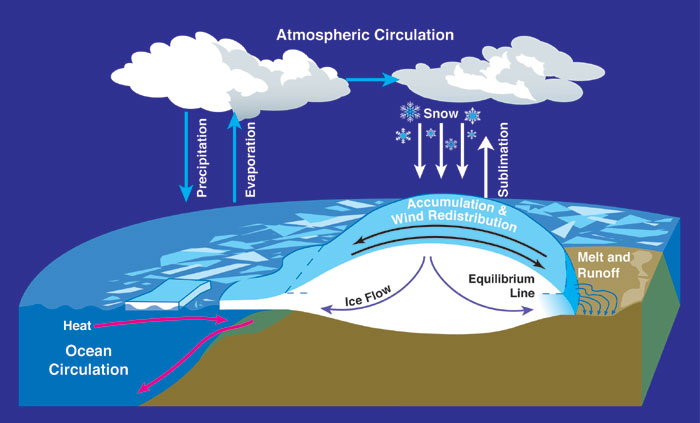CCfCS researchers use a combination of satellite, aircraft and ground-based observations and computer modelling to investigate topics related to ice sheets, permafrost, glaciers and ice-ocean-atmosphere interactions.
The cryosphere plays an important role in global climate processes. Ice permanently covers 10% of the land surface, with only a tiny fraction occurring outside Antarctica and Greenland. Ice also covers approximately 7% of the oceans in the annual mean. In midwinter, snow covers approximately 49% of the land surface in the Northern Hemisphere. An important property of snow and ice is its high surface albedo. Because up to 90% of the incident solar radiation is reflected by snow and ice surfaces, while only about 10% is reflected by the open ocean or forested lands, changes in snow and ice cover are important feedback mechanisms in climate change. In addition, snow and ice are effective insulators. Seasonally frozen ground is more extensive than snow cover, and its presence is important for energy and moisture fluxes.

Ice-ocean-atmosphere interactions. [Credit: NASA]
Recent observations and analyses of changes in ice include shrinkage of mountain glacier volume, decreases in snow cover, changes in permafrost and frozen ground, reductions in arctic sea ice extent, coastal thinning of the Greenland Ice Sheet exceeding inland thickening from increased snowfall, and reductions in seasonally frozen ground and river and lake ice cover. Based on analyses of tide gauge and satellite altimetry measurements, the rate of change of 20th century global sea level has been assessed as 1.7 ± 0.5 mm yr–1. Changes in the cryosphere affect not only eustatic sea level, but also regional sea level as a result of glacial isostatic re-adjustment. Likely consequences of rising sea level include increased coastal erosion, degradation of coastal ecosystems such as wetlands and coral reefs, and increased vulnerability of people in low-lying coastal urban areas, atolls and river deltas (especially Asian megadeltas).
Members of the Cryosphere and Sea-Level Research Interest Group use a combination of satellite, aircraft and ground-based observations and computer modelling to investigate:
- Ice sheet mechanics and dynamics
- Ice-ocean-atmosphere interactions
- Marine ice sheet stability
- Marine and subglacial sediment processes and glacial erosion
- Ice thickness and bed characteristics
- The glacial history of Greenland and Antarctica
- Ice-sheet hydrology including supraglacial and subglacial lakes
- Permafrost processes and dynamics

